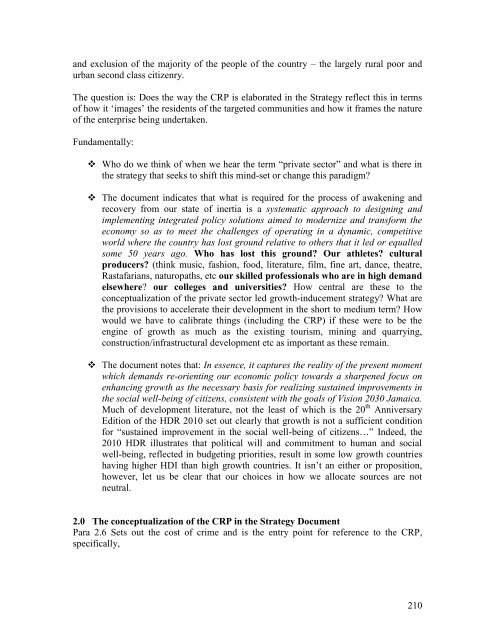PIOJ Growth-Inducement Strategy - Planning Institute of Jamaica
PIOJ Growth-Inducement Strategy - Planning Institute of Jamaica
PIOJ Growth-Inducement Strategy - Planning Institute of Jamaica
You also want an ePaper? Increase the reach of your titles
YUMPU automatically turns print PDFs into web optimized ePapers that Google loves.
and exclusion <strong>of</strong> the majority <strong>of</strong> the people <strong>of</strong> the country – the largely rural poor and<br />
urban second class citizenry.<br />
The question is: Does the way the CRP is elaborated in the <strong>Strategy</strong> reflect this in terms<br />
<strong>of</strong> how it ‘images’ the residents <strong>of</strong> the targeted communities and how it frames the nature<br />
<strong>of</strong> the enterprise being undertaken.<br />
Fundamentally:<br />
Who do we think <strong>of</strong> when we hear the term “private sector” and what is there in<br />
the strategy that seeks to shift this mind-set or change this paradigm?<br />
The document indicates that what is required for the process <strong>of</strong> awakening and<br />
recovery from our state <strong>of</strong> inertia is a systematic approach to designing and<br />
implementing integrated policy solutions aimed to modernize and transform the<br />
economy so as to meet the challenges <strong>of</strong> operating in a dynamic, competitive<br />
world where the country has lost ground relative to others that it led or equalled<br />
some 50 years ago. Who has lost this ground? Our athletes? cultural<br />
producers? (think music, fashion, food, literature, film, fine art, dance, theatre,<br />
Rastafarians, naturopaths, etc our skilled pr<strong>of</strong>essionals who are in high demand<br />
elsewhere? our colleges and universities? How central are these to the<br />
conceptualization <strong>of</strong> the private sector led growth-inducement strategy? What are<br />
the provisions to accelerate their development in the short to medium term? How<br />
would we have to calibrate things (including the CRP) if these were to be the<br />
engine <strong>of</strong> growth as much as the existing tourism, mining and quarrying,<br />
construction/infrastructural development etc as important as these remain.<br />
The document notes that: In essence, it captures the reality <strong>of</strong> the present moment<br />
which demands re-orienting our economic policy towards a sharpened focus on<br />
enhancing growth as the necessary basis for realizing sustained improvements in<br />
the social well-being <strong>of</strong> citizens, consistent with the goals <strong>of</strong> Vision 2030 <strong>Jamaica</strong>.<br />
Much <strong>of</strong> development literature, not the least <strong>of</strong> which is the 20 th Anniversary<br />
Edition <strong>of</strong> the HDR 2010 set out clearly that growth is not a sufficient condition<br />
for “sustained improvement in the social well-being <strong>of</strong> citizens…” Indeed, the<br />
2010 HDR illustrates that political will and commitment to human and social<br />
well-being, reflected in budgeting priorities, result in some low growth countries<br />
having higher HDI than high growth countries. It isn’t an either or proposition,<br />
however, let us be clear that our choices in how we allocate sources are not<br />
neutral.<br />
2.0 The conceptualization <strong>of</strong> the CRP in the <strong>Strategy</strong> Document<br />
Para 2.6 Sets out the cost <strong>of</strong> crime and is the entry point for reference to the CRP,<br />
specifically,<br />
210
















